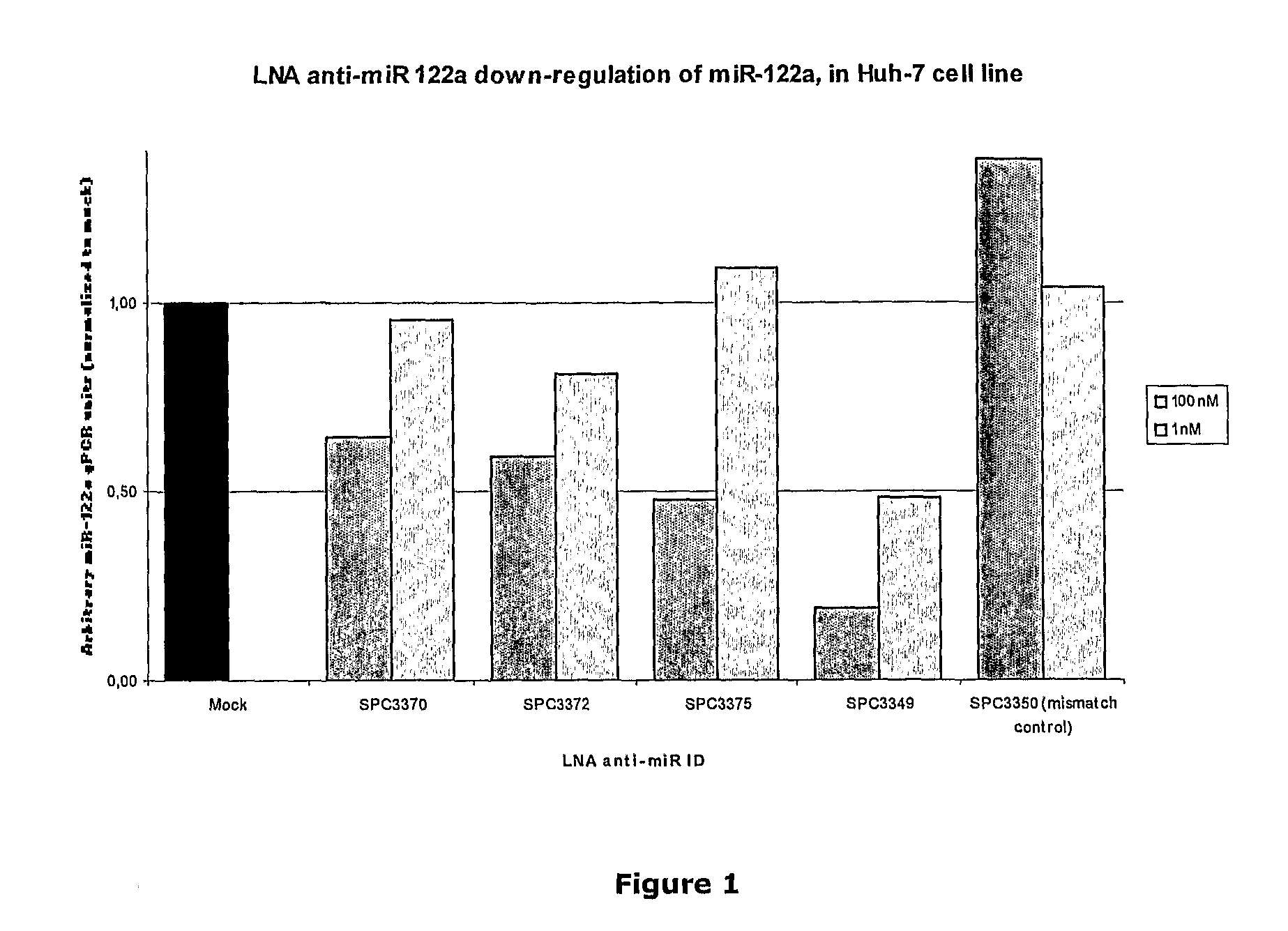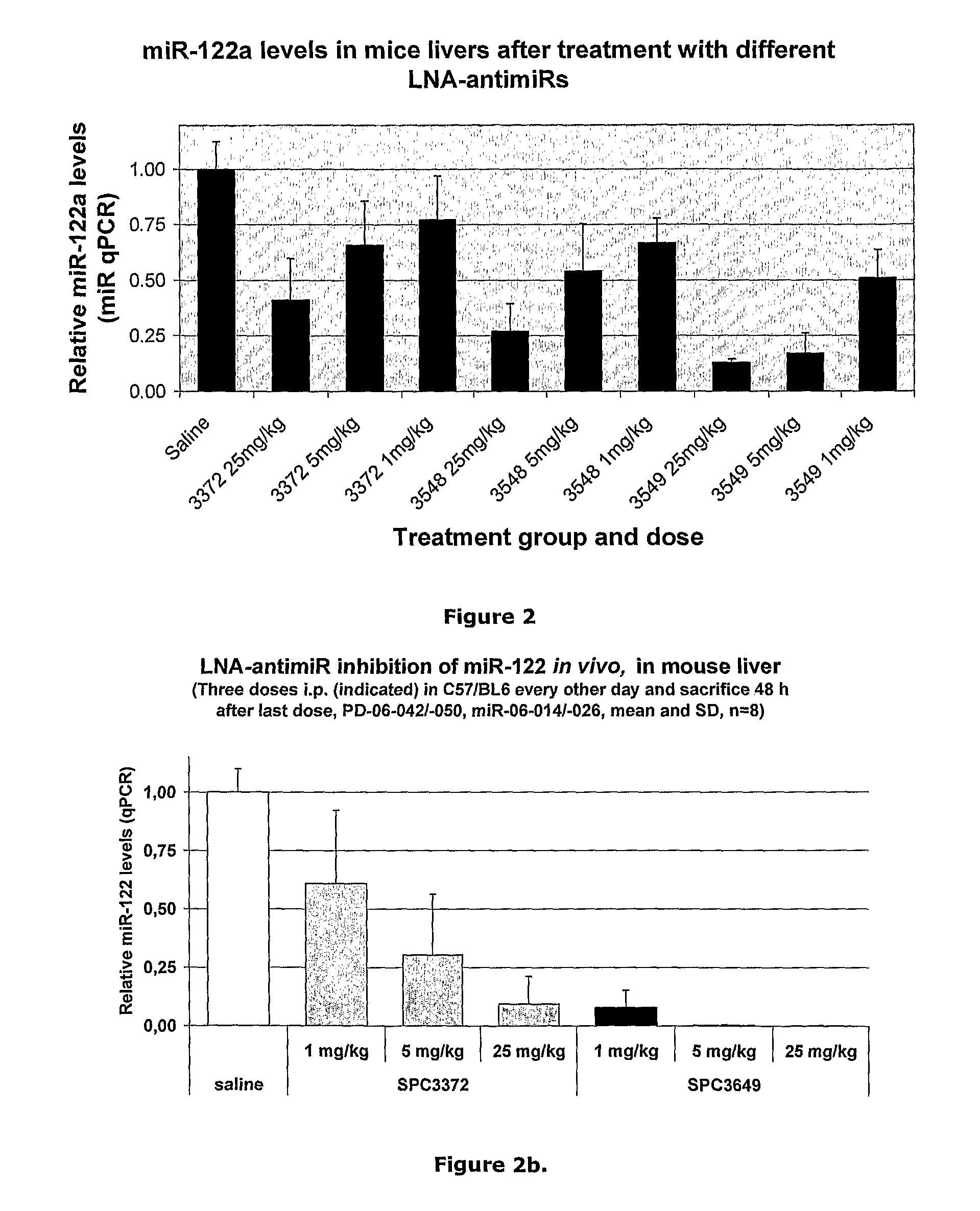Pharmaceutical composition comprising anti-mirna antisense oligonucleotide
a technology of anti-mirna and oligonucleotide, which is applied in the direction of digestive system, sugar derivatives, biochemistry apparatus and processes, etc., can solve the problems of high dosage (80 mg/kg) of 2′-o-me antagomir for efficient silencing, low in vivo stability, and toxicity to animals, so as to prevent the function of risk directed mirna, reduce the level of microrna, and avoid off-target effects
- Summary
- Abstract
- Description
- Claims
- Application Information
AI Technical Summary
Benefits of technology
Problems solved by technology
Method used
Image
Examples
example 1
Monomer Synthesis
[0505]The LNA monomer building blocks and derivatives thereof were prepared following published procedures and references cited therein, see, e.g. WO 03 / 095467 A1 and D. S. Pedersen, C. Rosenbohm, T. Koch (2002) Preparation of LNA Phosphoramidites, Synthesis 6, 802-808.
example 2
Oligonucleotide Synthesis
[0506]Oligonucleotides were synthesized using the phosphoramidite approach on an Expedite 8900 / MOSS synthesizer (Multiple Oligonucleotide Synthesis System) at 1 μmol or 15 μmol scale. For larger scale synthesis an Äkta Oligo Pilot (GE Healthcare) was used. At the end of the synthesis (DMT-on), the oligonucleotides were cleaved from the solid support using aqueous ammonia for 1-2 hours at room temperature, and further deprotected for 4 hours at 65° C. The oligonucleotides were purified by reverse phase HPLC (RP-HPLC). After the removal of the DMT-group, the oligonucleotides were characterized by AE-HPLC, RP-HPLC, and CGE and the molecular mass was further confirmed by ESI-MS. See below for more details.
[0507]Preparation of the LNA-Solid Support:
[0508]Preparation of the LNA Succinyl Hemiester
[0509]5′-O-Dmt-3′-hydroxy-LNA monomer (500 mg), succinic anhydride (1.2 eq.) and DMAP (1.2 eq.) were dissolved in DCM (35 mL). The reaction was stirred at room temperature...
example 3
Design of the LNA Anti-miR Oligonucleotides and Melting Temperatures
[0529]Target microRNA:
[0530]
SEQ ID NO: 1miR-122a: 5′-uggagugugacaaugguguuugu-3′(SEQ ID NO: 1 reverse orientation)miR-122a 3′ to 5′: 3′-uguuugugguaacagugugaggu-5′
[0531]
TABLE 1LNA anti-miR oligonucleotide sequences and Tm:SEQIDTmNO:Oligo IDSED IDSequence:(° C.)2SPC3370XxxXSEQ ID 565′-cCatTgtCacActCca-PS75design3′backbone3SPC3372XxxXSEQ ID 575′-ccAttGtcAcaCtcCa-PS69design3′backbone4SPC3375GapmerSEQ ID 585′-PS69CCAttgtcacacTCCa-3′backbone5SPC354915-merSEQ ID 595′-CcAttGTcaCaCtCC-PS783′backbone6SPC3550mismatchSEQ ID 605′-CcAttCTgaCcCtAC-PS32control3′backbone7SPC3373mismatchSEQ ID 615′-ccAttGtcTcaAtcCa-PS46control3′backbone8SPC354813-merSEQ ID 625′-AttGTcaCaCtCC-3′PSbackbone
[0532]lower case: DNA, uppercase: LNA (all LNA C were methylated), underlined: mismatch
[0533]The melting temperatures were assessed towards the mature miR-122a sequence, using a synthetic miR-122a RNA oligonucleotide with phosphorothioate linkaged.
[053...
PUM
| Property | Measurement | Unit |
|---|---|---|
| Tm | aaaaa | aaaaa |
| Tm | aaaaa | aaaaa |
| Tm | aaaaa | aaaaa |
Abstract
Description
Claims
Application Information
 Login to View More
Login to View More - R&D
- Intellectual Property
- Life Sciences
- Materials
- Tech Scout
- Unparalleled Data Quality
- Higher Quality Content
- 60% Fewer Hallucinations
Browse by: Latest US Patents, China's latest patents, Technical Efficacy Thesaurus, Application Domain, Technology Topic, Popular Technical Reports.
© 2025 PatSnap. All rights reserved.Legal|Privacy policy|Modern Slavery Act Transparency Statement|Sitemap|About US| Contact US: help@patsnap.com



